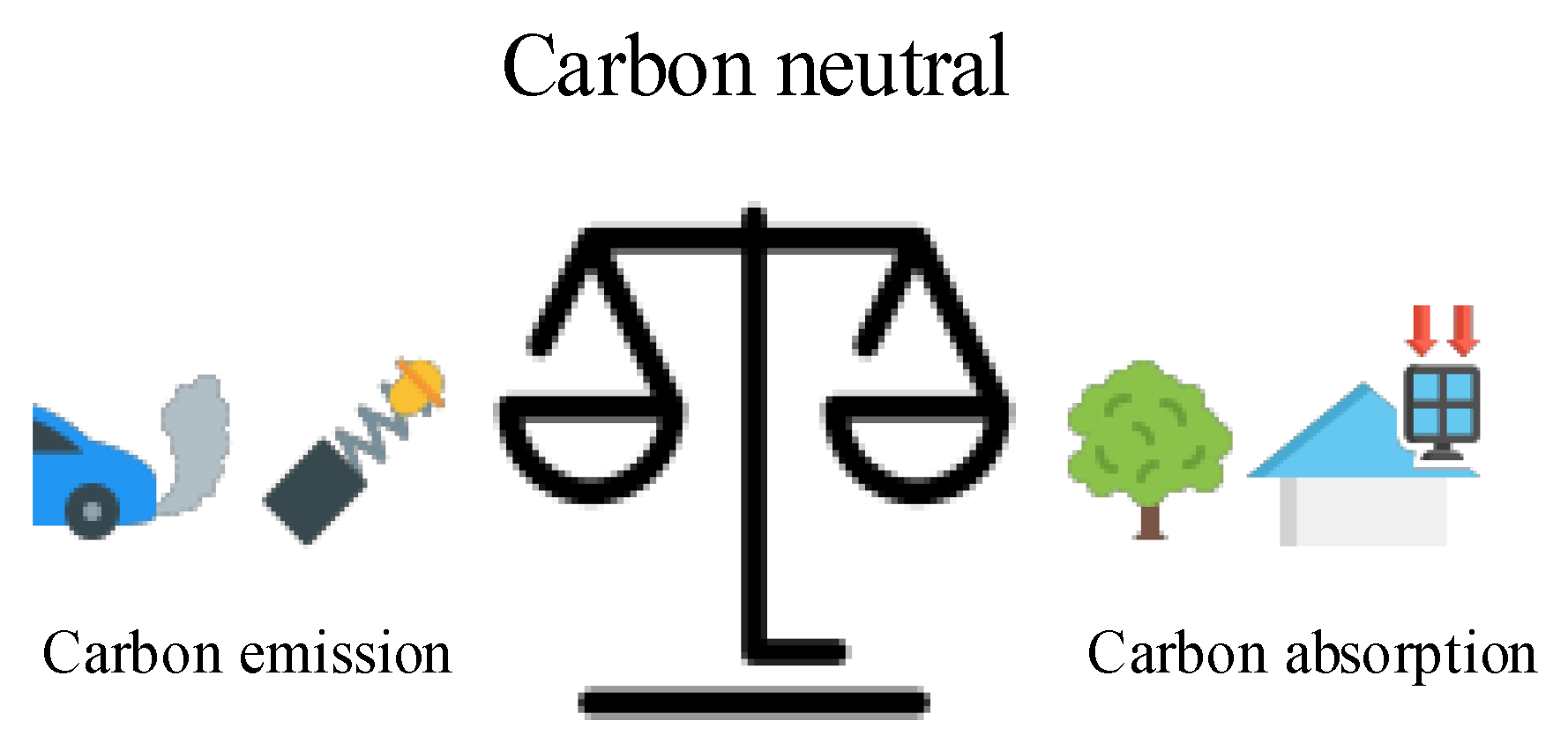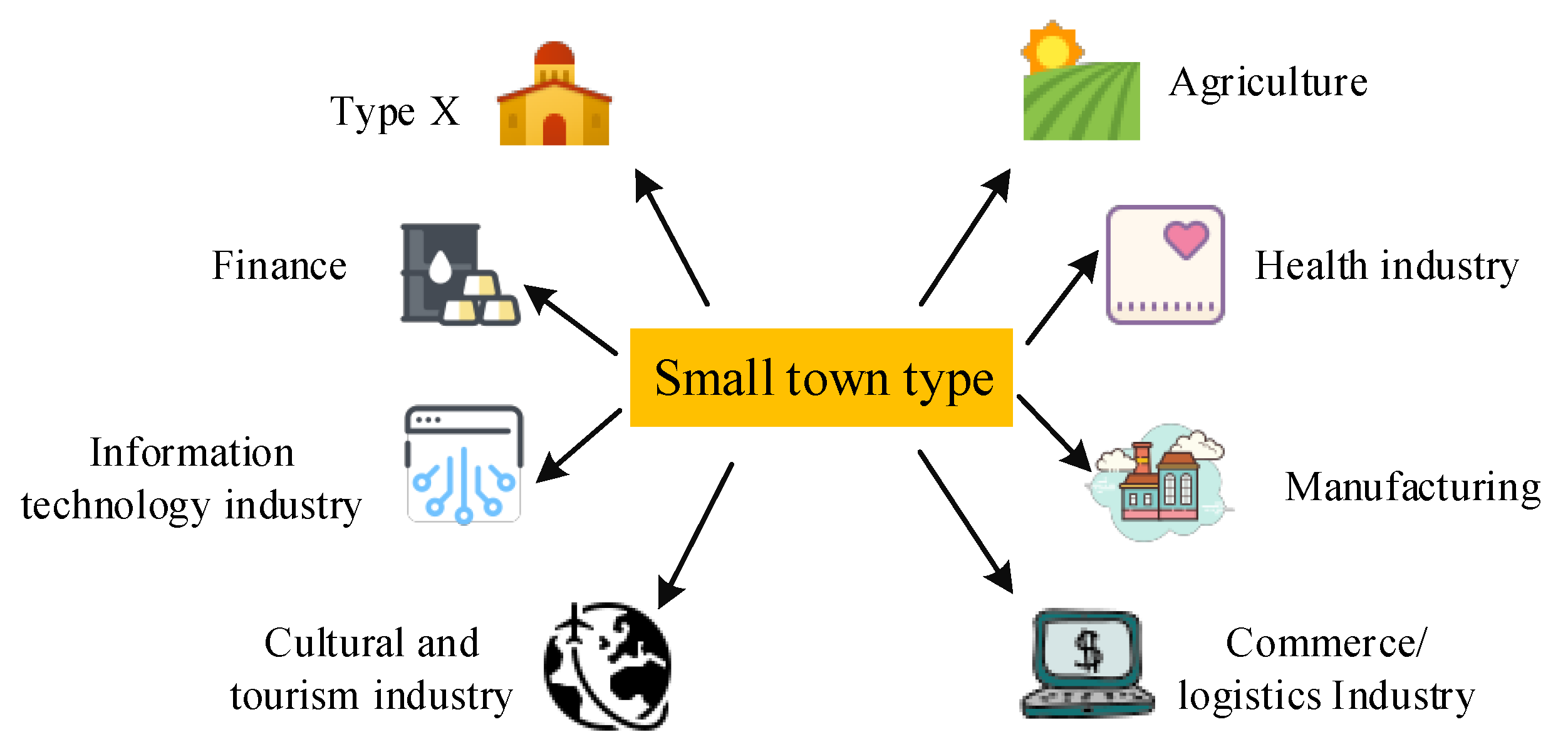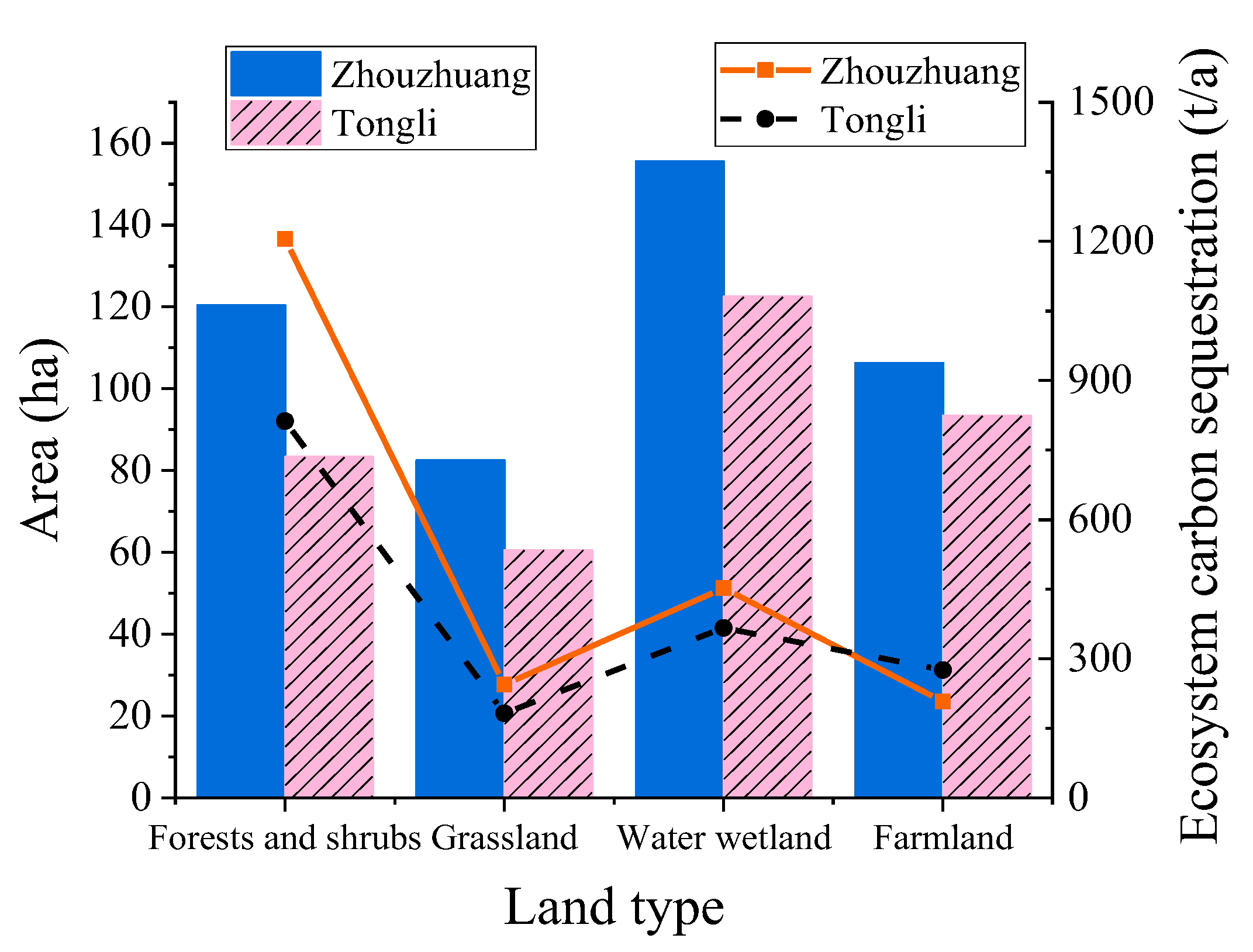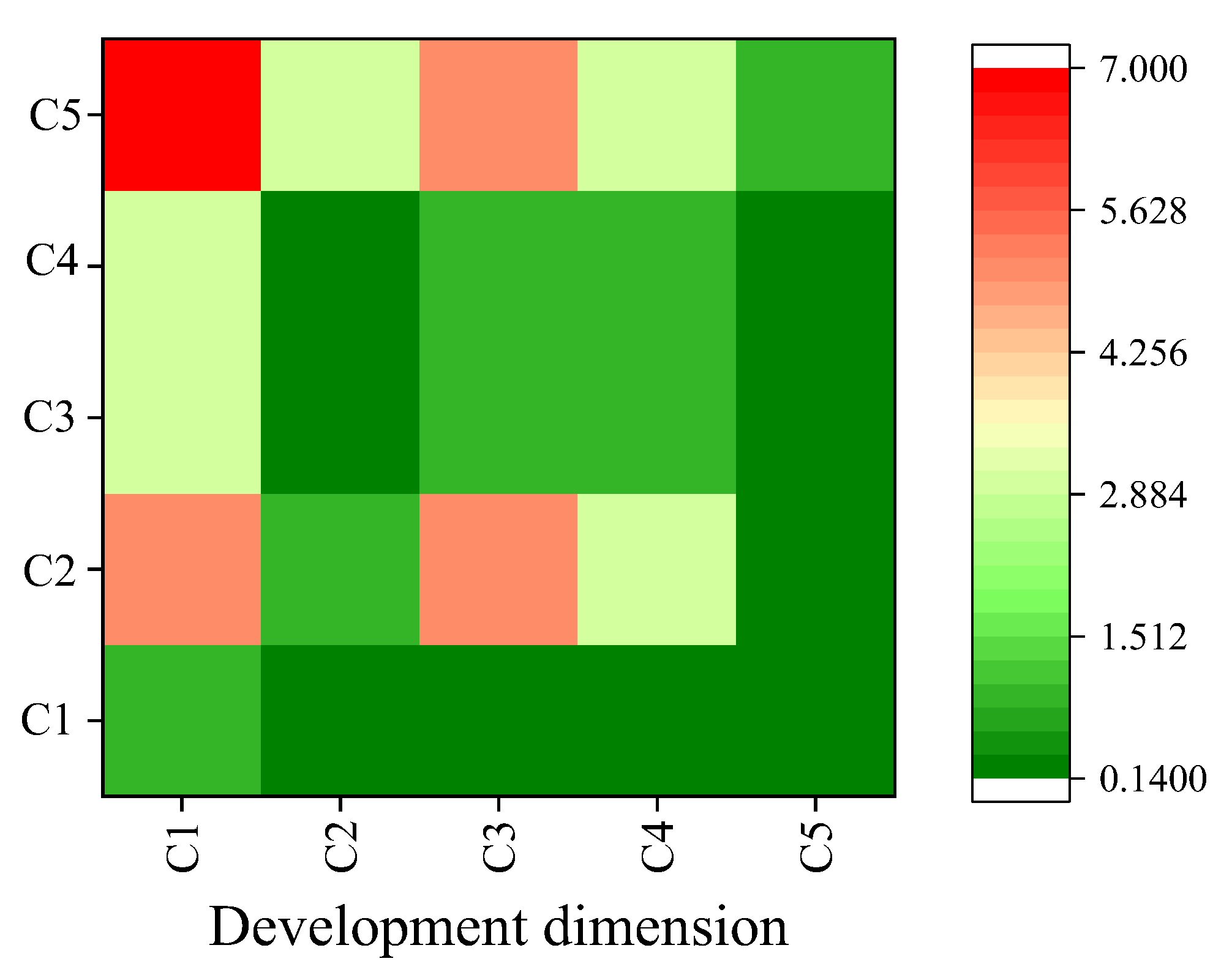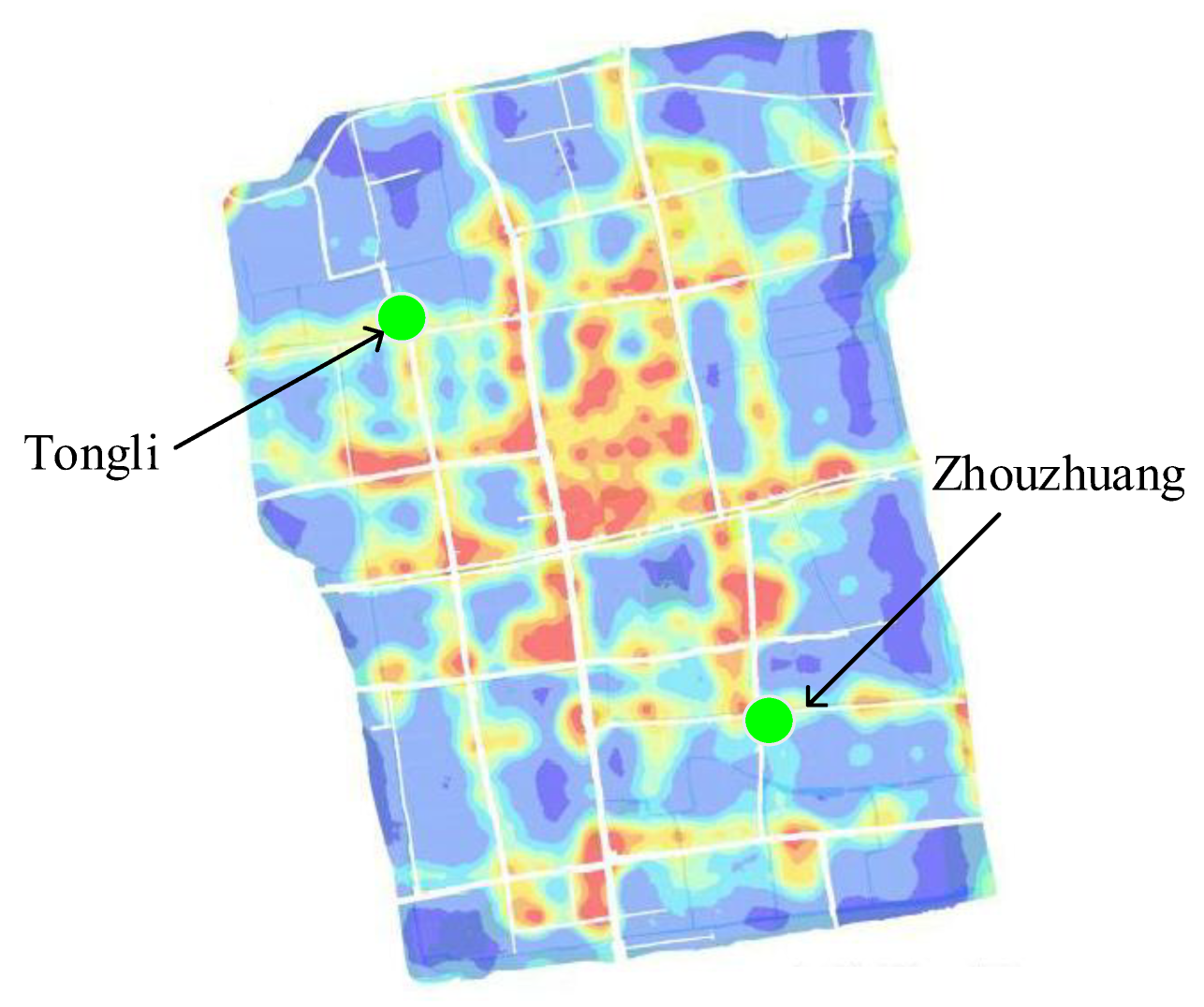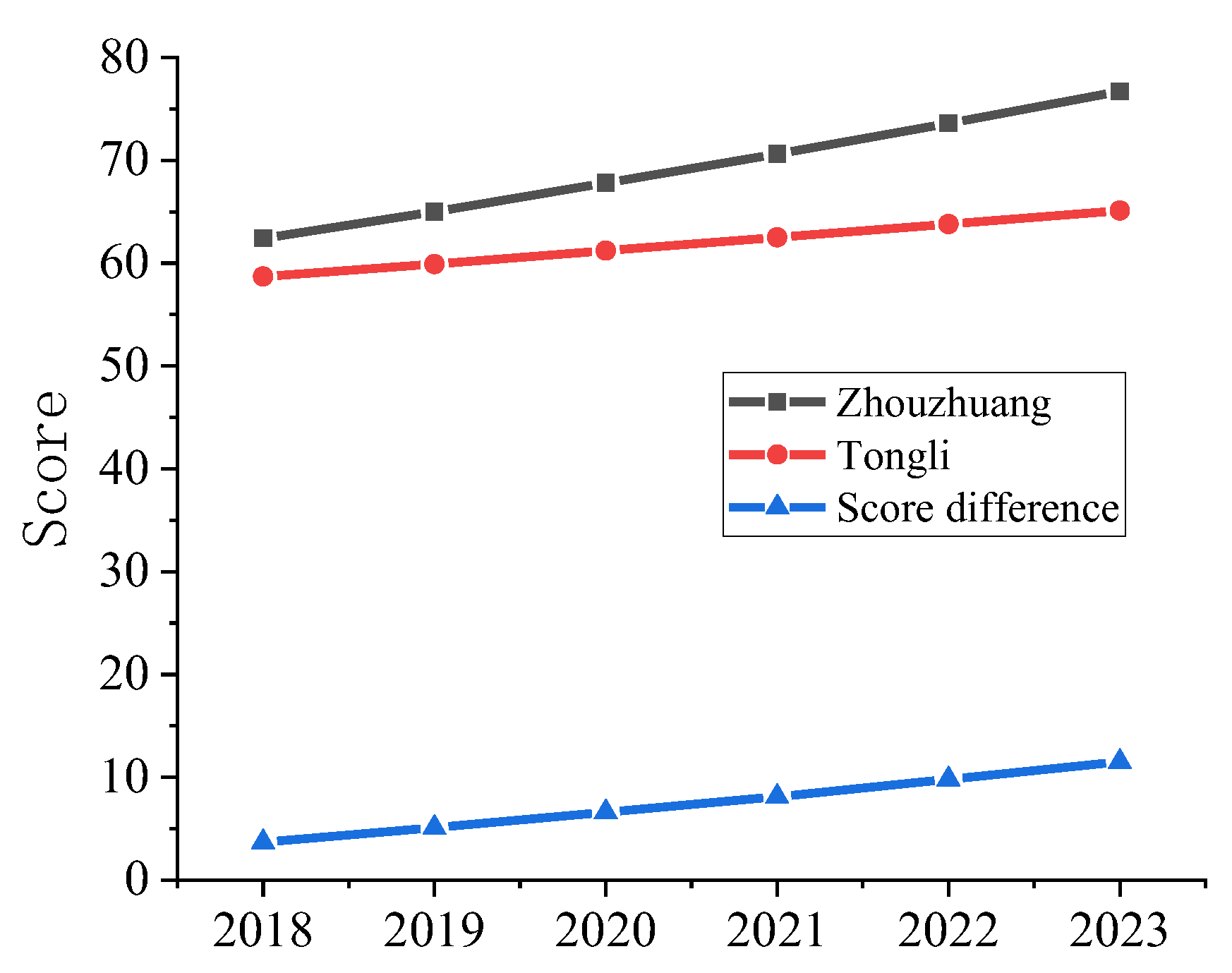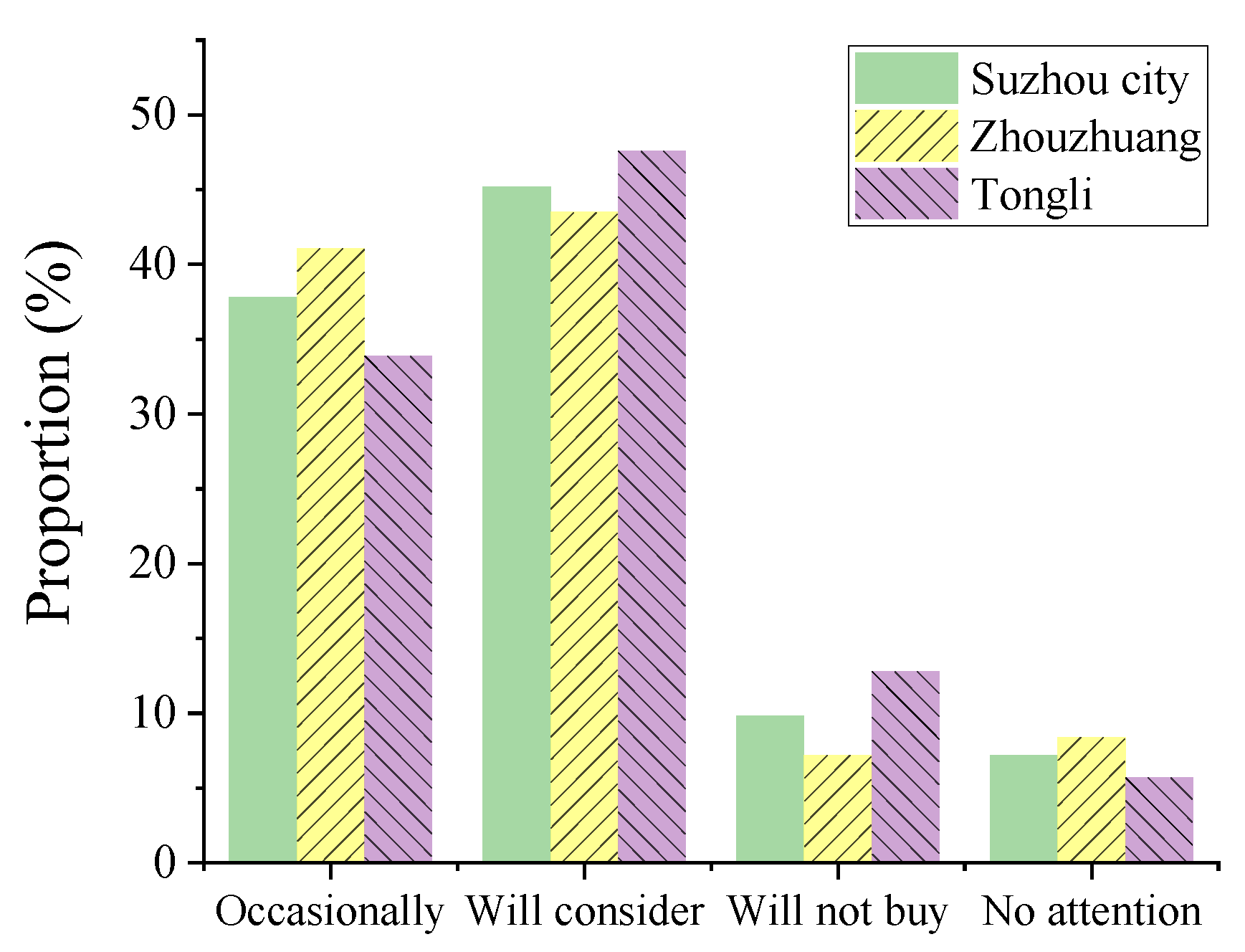3.1. Research Subjects
This study selects Zhouzhuang and Tongli—two ancient towns in Suzhou, Jiangsu Province—as case study sites. A scenic overview of both towns is presented in
Figure 5. Renowned for their rich historical and cultural heritage, as well as their distinctive natural landscapes, Zhouzhuang and Tongli are among China’s most famous water towns and continue to attract large numbers of domestic and international tourists. Zhouzhuang, located in Kunshan City, is particularly recognized as one of China’s four most celebrated ancient towns.
In recent years, Zhouzhuang has actively promoted low-carbon tourism by enhancing infrastructure and encouraging technological innovation. The town has established a well-integrated public transportation system and an extensive network of bike lanes, making it easier for tourists to choose environmentally friendly travel options. Tongli, located in Wujiang District, Jiangsu Province, is another renowned historical and cultural town. Known for its rich heritage, long history, and iconic water-town scenery, Tongli continues to attract a significant number of visitors.
Figure 6 presents the land use classifications and ecosystem carbon sequestration statistics for both characteristic towns.
The questionnaire used in this study was designed based on the theoretical framework of a three-dimensional impact mechanism involving tourists, residents, and enterprises in the transition to low-carbon tourism. This framework served as the guiding principle for developing the questionnaire content. Data from tourists were gathered using structured questions that focused on specific consumption behaviors during their travels, such as transportation choices, accommodation preferences, and participation in tourism activities. Sample items include the following: “What was your primary mode of transportation during this trip? (Options: public transport, private car, bicycle, etc.)” and “Did you choose to stay in an eco-friendly hotel? (Options: Yes, No)”. A five-point Likert scale (1 = Never, 5 = Always) was employed to measure the frequency of low-carbon behaviors. To determine the weights of evaluation indicators, the Delphi method was used, ensuring scientific rigor and expert input. The Delphi method involves a structured, multi-round process to achieve expert consensus. In the first round, experts were presented with a preliminary set of indicators and proposed weights and were invited to provide feedback. Based on their input, the indicators and weights were revised. A second round of consultation was then conducted to refine these elements further. Finally, the revised indicators and weights were consolidated and returned to the experts for confirmation. This iterative approach ensured the questionnaire’s validity, reliability, and practical relevance to the context of low-carbon tourism.
During the questionnaire development phase, a preliminary study was conducted, incorporating both pilot surveys and expert interviews. The pilot survey was carried out in the two selected case study sites—Zhouzhuang and Tongli, ancient towns in Suzhou, Jiangsu Province. A total of 50 questionnaires were distributed, with 48 valid responses collected, yielding a 96% response rate. Concurrently, expert interviews were conducted with five tourism professionals, who evaluated the questionnaire’s clarity, logical structure, and overall relevance. Based on feedback from both the pilot survey and expert consultations, the questionnaire was revised to enhance its quality and applicability. To evaluate the instrument’s quality, both reliability and validity tests were performed. Reliability was assessed using Cronbach’s alpha, which measures internal consistency. All dimensions had Cronbach’s alpha values above 0.7, indicating high reliability. Validity was tested using the Kaiser–Meyer–Olkin (KMO) measure and Bartlett’s test of sphericity to assess the data’s suitability for factor analysis. The KMO values were 0.85 for the tourist questionnaire, 0.82 for the resident questionnaire, and 0.78 for the enterprise questionnaire, all exceeding the acceptable threshold. Bartlett’s tests were significant (p < 0.01), confirming the appropriateness of factor analysis. Factor extraction yielded the following results: For the tourist questionnaire, three factors were identified—low-carbon transportation, low-carbon consumption, and low-carbon awareness—with a cumulative variance contribution of 68.3%. The resident questionnaire revealed two factors, namely low-carbon behavior and low-carbon awareness, explaining 72.1% of the variance. The enterprise questionnaire produced two factors, namely technological investment and green management, accounting for 69.5% of the total variance. All item factor loadings exceeded 0.5—for example, “use of public transportation” loaded at 0.72 and “participation in waste sorting” loaded at 0.68. All loadings were statistically significant (p < 0.01), indicating strong correlations between items and their respective factors.
This study adopts a mixed-methods approach, combining on-site and online surveys to gather data from the public. A total of 1804 questionnaires were distributed, with 1736 valid responses collected, resulting in an overall response rate of 96.23%. Specifically, 540 questionnaires were distributed to local residents, yielding 520 valid responses—232 from Zhouzhuang and 288 from Tongli. For tourists, 744 questionnaires were distributed, with 720 valid responses—336 from Zhouzhuang and 384 from Tongli.
The mixed-methods approach adopted in this study aligns with the integrated assessment methodology advanced by Mondal and Samaddar (2022) [
59], who argue that complex sustainability transitions require both quantitative measurements and qualitative insights into stakeholder perceptions. Their comprehensive literature review identifies methodological triangulation as a critical requirement for advancing responsible tourism research. The integration of survey data, in-depth interviews, and focus groups significantly enhances the validity and reliability of findings, particularly when examining multidimensional phenomena, like low-carbon tourism transformation. This methodological synergy enables a more comprehensive understanding of both the measurable impacts and the subjective experiences that shape stakeholder engagement in sustainability initiatives.
Table 1 provides a detailed breakdown of distribution and recovery rates across the different survey channels. To enrich the data collection process, qualitative methods were also employed, including in-depth interviews and focus group discussions. In Zhouzhuang and Tongli, 20 in-depth interviews were conducted with tourists and residents to explore their perceptions, attitudes, and behaviors regarding low-carbon tourism. Additionally, 2 focus group discussions—each comprising 8 to 10 participants—were held to identify perceived barriers and enabling factors in promoting low-carbon tourism. These qualitative methods provided deeper, more nuanced insights into the study questions. For the enterprise dimension, data were collected through a combination of online questionnaires, telephone interviews, and face-to-face interviews to ensure methodological rigor and scientific validity. The focus was on tourism-related businesses, including hotels, travel agencies, scenic spots, restaurants, transportation services, and retail establishments that directly support the tourism sector. This multi-faceted data collection strategy was designed to enhance the accuracy, reliability, and representativeness of the study’s findings.
To ensure a comprehensive and representative dataset, the sample was stratified into three primary groups, namely tourists, residents, and enterprises. Within the tourist group, stratification was based on place of origin (domestic or international), age, and gender. For residents, the criteria included age, occupation, and length of residence. Enterprise sampling considered business type (e.g., hotel, travel agency, scenic site) and company size. The sample focused on the two case study sites—Zhouzhuang and Tongli—and included respondents from major tourist attractions and residential areas within both towns. Among tourists, 48% were male and 52% were female. The age distribution was as follows: 35% were aged 18–30, 40% were aged 31–45, 20% were aged 46–60, and 5% were over 60. Among residents, 46% were male and 54% were female, with 25% aged 18–30, 35% aged 31–45, 30% aged 46–60, and 10% over 60. Resident occupations included workers, farmers, merchants, students, teachers, and public servants, with a relatively high proportion of students, educators, and government employees. To reduce potential sampling bias and enhance representativeness, the study employed a combination of data collection methods, including on-site surveys, online questionnaires, and telephone interviews. This multi-channel strategy broadened the sample coverage and improved the overall validity of the study findings.
3.2. Construction of Evaluation Indicator System of Low-Carbon Tourism Transformation Level in Characteristic Towns
This study establishes a set of quantitative indicators to enable a more scientific and systematic evaluation of the low-carbon tourism transformation in characteristic towns. Simultaneously, indicator weights were determined through expert consultation and analyzed using ADAHPVersion 2.1 software. The ADAHP platform aggregates expert evaluations and conducts consistency checks on the judgment matrix to ensure logical coherence and internal reliability in the results. Based on this process, a comprehensive indicator system was developed, integrating both low-carbon and development dimensions. A detailed list of these indicators is provided in
Table 2.
In the low-carbon dimension, carbon emissions serve as a core indicator, directly reflecting the total emissions generated by tourism activities and, thus, providing a primary measure of low-carbon transformation effectiveness. Data for this indicator are obtained from energy consumption and transportation emission statistics provided by tourism enterprises and transportation departments. Energy efficiency is measured by energy consumption per unit area, indicating how efficiently resources are utilized. These data come from energy usage reports from tourism enterprises and energy authorities. Low-carbon buildings refer to structures constructed with low-carbon technologies and materials; their prevalence is measured by the proportion of such buildings. Relevant data are sourced from construction statistics maintained by tourism enterprises and construction departments. Green transportation promotes the use of public transit and new energy vehicles to reduce private car usage. The proportion of trips made using these low-carbon transport modes is used as the indicator, based on traffic flow data from transportation departments.
In the development dimension, the tourism revenue growth rate reflects the sector’s economic expansion and serves as a key indicator of tourism development effectiveness. Data for this metric are drawn from tourism revenue reports issued by tourism and statistical departments. New employment opportunities indicate the extent to which tourism development generates local jobs, measured by the proportion of newly employed individuals in the tourism sector. This information is provided by tourism and human resources departments. The development of characteristic industries captures how towns leverage their unique resources to foster distinctive industries, measured by the proportion of total industry output attributed to these sectors. Data for this indicator are sourced from tourism and statistical department records.
In the sustainable tourism dimension, the cultural heritage protection rate reflects the extent to which characteristic towns preserve their cultural assets amid tourism development. Data for this indicator are sourced from statistics maintained by cultural and tourism departments. Community participation measures the degree of local resident involvement in tourism-related activities and serves as a key indicator of sustainable tourism effectiveness. It is quantified by the proportion of residents actively participating in tourism, based on data from community and tourism departments. The distribution of tourism revenue is critical for ensuring stakeholder engagement and equity in tourism development. This indicator assesses the fairness of income distribution among governments, residents, and enterprises, measured by the respective shares of total tourism revenue. Relevant data are obtained from financial and tourism department records.
The overall evaluation indicator system is structured across three dimensions—low-carbon, development, and sustainable tourism—organized into three hierarchical levels, namely target, criterion, and indicator. During the indicator selection process, expert consultation was conducted with a panel of eight specialists. This group included five professors or senior researchers in environmental science, tourism management, and policy studies, and three associate professors. All experts hold doctoral degrees and possess over 10 years of professional experience. Notably, two experts have participated in provincial-level low-carbon tourism planning projects, and three have published high-impact papers on low-carbon tourism topics.
The expert consultation process involved several key stages. First, experts were selected based on clearly defined objectives and selection criteria. Multiple rounds of interviews and feedback sessions were then conducted to ensure each expert had sufficient opportunity to provide input. The collected feedback was synthesized into a preliminary weighting scheme for the evaluation indicators. This draft was circulated for further review and refinement until a consensus was achieved. In the first round, 35 preliminary indicators were proposed, covering topics, such as low-carbon transportation, green buildings, energy consumption, environmental protection, social participation, and policy support. The second round focused on evaluating the importance of each indicator, resulting in the finalized set of indicators and their corresponding weights. Examples of questionnaire items and expert feedback records were collected during the study design phase. The calculation process and results for the criterion-level indicator weights are presented in
Table 3.
A chained mediation model was employed using structural equation modeling (SEM) to validate the following pathway: policy support → enterprise investment → resident behavior → low-carbon outcomes. The specific steps were as follows: (1) AMOS 26.0 software was used to estimate the path coefficients, yielding a standardized path coefficient (β) of 0.42 (
p < 0.01); (2) the bootstrap method was applied to test the indirect effects, producing a 95% confidence interval of [0.25, 0.61], with indirect effects accounting for 81% of the total effect.
Figure 7 and
Figure 8 display the indicator weight calculations for the low-carbon dimension (B) and the development dimension (C), respectively. In the low-carbon dimension, indicators B1 through B5 represent low-carbon infrastructure, awareness, consumption, operations, and management, with corresponding weights of 0.0993, 0.2357, 0.1824, 0.1716, and 0.1110, respectively. In the development dimension, indicators C1 to C5 reflect economic development, social progress, environmental quality, characteristic industries, and town appearance, with respective weights of 0.0920, 0.0168, 0.0457, 0.0358, and 0.0097. As shown in
Figure 6, Zhouzhuang scores higher in “low-carbon infrastructure” (B1, 9.9%) and “low-carbon consumption” (B3, 18.2%), demonstrating its strengths in areas, such as new energy bus coverage (70% in Zhouzhuang vs. 30% in Tongli) and the proportion of low-carbon hotels (65% in Zhouzhuang vs. 20% in Tongli).
Figure 7 further indicates that while both towns have comparable scores in “economic development” (C1, 9.2%), Zhouzhuang has enhanced its low-carbon performance through supportive policies, such as offering a 50% subsidy for green building renovations.
In this study, the analytic hierarchy process (AHP) was employed as a key tool for determining the weights of evaluation indicators. Through expert consultations and multiple rounds of Delphi analysis, 23 core indicators were finalized. Experts from relevant fields rated the importance of each indicator on a 1–5 scale. These scores were then processed using ADAHP software, which performed the necessary calculations and consistency checks. The resulting consistency ratio (CR) was 0.08, below the acceptable threshold of 0.1, indicating reliable consistency. The final weight allocations were as follows: tourist behavior (25%), resident awareness (30%), and enterprise investment (45%). Furthermore, the dimension weights were established as follows: low-carbon (0.6818), development (0.2778), and sustainable tourism (0.0404). The consistency indices (CIs) for these dimensions were 0.05, 0.06, and 0.07, respectively. Expert consensus was also evaluated using Kendall’s W, which yielded a value of 0.72 with a
p-value < 0.01, confirming a high degree of agreement among experts. A comparison of low-carbon practices between enterprises in Zhouzhuang and Tongli (
Table 4) reveals that Zhouzhuang outperforms Tongli in such areas as renewable energy utilization, carbon emission intensity, and waste recycling rates. This advantage is likely due to stronger policy support for low-carbon initiatives and more proactive engagement from enterprises in Zhouzhuang. According to the comprehensive evaluation results presented in
Table 4, the overall low-carbon tourism transformation score for Suzhou’s characteristic towns is 63.3. This reflects a slightly above-average level of progress, indicating that while efforts have been made, the transformation remains moderate overall. Notably, Zhouzhuang scored 66.9, compared to 57.6 for Tongli—a difference of 9.3 points—highlighting a significant disparity in transformation performance between the two towns. Zhouzhuang outperforms Tongli in implementing low-carbon initiatives, including the promotion of green buildings, adoption of renewable energy, and improvements to public transportation. These efforts have significantly advanced its transformation toward low-carbon tourism. In contrast, both towns show comparable performance in the development dimension, with similar outcomes in infrastructure, economic growth, and social services. Suzhou is home to 438 protected cultural relic sites and controlled buildings at various administrative levels, representing 41.6% of the city’s immovable cultural relics. This gives Suzhou the highest number and density of such sites in China. However, Zhouzhuang’s indicator for architectural heritage protection has shown a downward trend. In 2000, large-scale maintenance was conducted on historic buildings, covering 21% of the town’s total. Since then, the annual maintenance rate has not exceeded 8%. In comparison, Tongli has 3 national-level protected cultural relic sites, with 4 provincial-level sites, 16 at the municipal level, 114 immovable cultural relics, and 1 World Cultural Heritage site.
Figure 9 presents the carbon emission heat maps for the two ancient towns. The heat maps use a red–yellow–blue gradient to represent carbon emission intensity: red indicates high-emission areas (>1.0 kg CO
2/m
2/year), yellow represents medium-emission areas (0.5–1.0 kg CO
2/m
2/year), and blue denotes low-emission areas (<0.5 kg CO
2/m
2/year). In Zhouzhuang, the central commercial district appears red due to concentrated dining and transportation activities, while residential zones appear blue as a result of low-density development. The emission pattern in Zhouzhuang shows predominantly red zones in the central and southern parts of the town, with yellow areas elsewhere. This distribution is largely attributable to the concentration of commercial activities, such as restaurants, shopping areas, and tourism facilities, which drive up energy consumption and transportation emissions. In contrast, Tongli’s emission map reveals predominantly blue zones in the northern and eastern areas, indicating significantly lower carbon emissions.
This study assesses the comprehensive low-carbon tourism transformation scores of Zhouzhuang and Tongli from 2018 to 2023, using the HP filter to extract long-term trends. As shown in
Figure 10, Zhouzhuang’s score increased from 62.4 to 81.3, reflecting an average annual growth rate of 4.2%. In comparison, Tongli’s score rose from 58.7 to 71.5, with an average annual growth rate of 2.1%. Notably, after the implementation of stronger policies in 2021, Zhouzhuang’s growth rate accelerated by 1.8%. Multidimensional cross-analysis reveals that in areas where enterprises quickly adapt to technological upgrades and policy shifts—paired with high levels of resident participation—low-carbon performance can improve by up to 37%. Managerial innovation yields the greatest impact (a 28% improvement) in regions with moderate policy responsiveness and resident involvement. Moreover, carbon sink trading contributes a 19% improvement even in areas with low resident participation, provided that policy responsiveness remains high. Zhouzhuang’s success can be attributed to the synergy between policy incentives (e.g., subsidies and performance evaluations) and community engagement (e.g., a point-based incentive system), fostering a positive feedback loop of “tourist preference → enterprise action → community response”. In contrast, Tongli struggles with weak policy enforcement, which diminishes enterprise motivation. Limited resident participation further dampens tourist demand, creating a negative cycle of “low demand → low supply”.
To examine the relationships among key variables within the tourism system, this study employs Pearson correlation analysis. Specifically, it investigates the link between tourist satisfaction and residents’ awareness of low-carbon consumption. The results reveal a significant positive linear relationship, with a correlation coefficient of 0.68 (
p < 0.01). The model validation results support recent theories of sustainable tourism governance, which posit that successful sustainability transitions depend on the quality and strength of relationships between key stakeholders rather than isolated interventions. Our empirical findings extend the theoretical perspectives synthesized by Yang et al. (2023) [
60] in their comprehensive analysis of the sustainable tourism literature by quantifying the mediating mechanisms through which policy support is translated into tangible low-carbon outcomes via enterprise investment and resident behavior. Particularly noteworthy is the standardized path coefficient (β = 0.72) between resident behavior and low-carbon effects, which aligns with their identification of community engagement and behavioral change as critical factors in sustainable tourism implementation. A comparative analysis of low-carbon practices among enterprises in the two regions is presented in
Table 5. SEM is used to validate the proposed three-dimensional impact mechanism. The analysis shows that tourists’ low-carbon preferences significantly influence enterprises’ green supply behavior (path coefficient β = 0.32,
p < 0.01). Furthermore, enterprises’ low-carbon practices positively affect residents’ low-carbon awareness (β = 0.28,
p < 0.05). Building on these findings, a multiple linear regression model is developed, with residents’ low-carbon awareness as the independent variable (X) and tourist satisfaction as the dependent variable (Y), while controlling for potential confounding factors, such as education and income levels. The standardized regression coefficient is 0.73 (
p < 0.01), indicating that a 1 standard deviation increase in residents’ awareness is associated with a 0.73-unit increase in tourist satisfaction.
Table 6 presents the results of the structural equation model used to validate the theoretical framework of the three-dimensional mechanism. The model demonstrates a strong fit with the data: the comparative fit index (CFI) is 0.94, exceeding the acceptable threshold of 0.90; the Tucker–Lewis index (TLI) is 0.92, indicating an optimal model fit; the root mean square error of approximation (RMSEA) is 0.05, below the 0.06 threshold, suggesting minimal parameter estimation error; and the standardized root mean square residual (SRMR) is 0.04, well below the 0.08 cutoff, confirming a strong alignment between observed and latent variables. These fit indices collectively support the theoretical model, validating the dynamic causal relationships among tourists, residents, and enterprises.
Path analysis was conducted using AMOS 26.0. In the model, policy support is treated as an exogenous latent variable, while enterprise investment and resident behavior are modeled as endogenous latent variables. The low-carbon effect serves as the final dependent variable. Mediation analysis results are presented in
Table 7. The path coefficients—policy support → enterprise investment (β = 0.68), enterprise investment → resident behavior (β = 0.55), and resident behavior → low-carbon effect (β = 0.72)—highlight the critical mediating role of enterprises in the transformation process. Although green building subsidies have been effective in raising low-carbon performance, they have also increased operational costs for enterprises. For instance, hotel renovation costs in Zhouzhuang rose by 20%, underscoring the need to balance economic feasibility with environmental benefits.
Table 8 reports the results of the sensitivity analysis. Scenario 1 examines variations in policy enforcement intensity. Scenario 2 simulates external shocks, such as energy price fluctuations. Scenario 3 explores changes in tourist behavior and preferences. The findings indicate that the cancellation of Zhouzhuang’s low-carbon building subsidy (a reduction from 50% to 0%) resulted in a 15% decrease in the proportion of green buildings. A 20% increase in natural gas prices led to a regression in the energy structure toward coal usage, causing a 15% rise in carbon emission intensity. Moreover, a decline in tourists’ low-carbon awareness contributed to a 20% drop in the adoption rate of green transportation options.
3.4. Policy Suggestion of Low-Carbon Tourism Transformation in Characteristic Towns
Amid growing global concerns over climate change and the pursuit of carbon neutrality, the low-carbon transformation of tourism in characteristic towns has become increasingly urgent. This study proposes a closed-loop system of “policy-driven, community-responsive, and market-innovative” transformation, offering a distinct contrast to Copenhagen’s low-carbon strategy. Whereas Copenhagen emphasizes mandatory regulations and civic engagement—such as the promotion of public transport, cycling, and green buildings—this study, using Zhouzhuang as a case example, highlights the synergy between policy and market mechanisms. Zhouzhuang’s transformation relies on a combined approach of 50% renovation subsidies and a carbon points incentive system for residents, reflecting a collaborative model between government and market actors. While Copenhagen’s success is supported by the high acceptance levels of a wealthy population, China’s characteristic towns must consider economically disadvantaged groups, underscoring the need for localized policy design.
In Zhouzhuang, subsidies for the low-carbon renovation of historic buildings are primarily funded through two channels, with 60% coming from Suzhou’s Low-Carbon Development Fund and 40% coming from a designated portion of the town’s tourism ticket revenue. This funding structure not only ensures relative financial stability for the subsidies but also channels tourism income directly back into the transformation process, creating a virtuous cycle of sustainable development. The subsidy implementation process faced minimal resistance from stakeholders. Although some business owners initially expressed concerns over renovation costs and return on investment timelines, these doubts were alleviated through government-led policy briefings, expert consultations, and successful case demonstrations. From a theoretical perspective, this study advances the institutional analysis of protected areas and tourism destinations proposed by Nyaupane et al. (2022) [
47]. Their research suggests that tourism destinations operate within nested institutional arrangements characterized by varying degrees of formality, temporal scales, and spatial jurisdictions. Our findings confirm that low-carbon transformation in characteristic towns is indeed shaped by the interplay between formal institutions (e.g., government regulations and subsidy mechanisms) and informal institutions (e.g., community norms and tourist expectations). The chain mediation model empirically validates the theoretical proposition that institutional alignment across different stakeholder groups significantly enhances the efficiency of sustainability transitions. This extends beyond conventional stakeholder theory by emphasizing not only stakeholder identification and interest management but also the dynamic institutional processes that enable or constrain stakeholder agency in sustainability governance.Over time, business owners have recognized the long-term benefits of low-carbon upgrades, such as reduced energy costs and increased appeal to environmentally conscious tourists, and became active participants in the transformation. When comparing the cost-effectiveness of green building subsidies with public transportation incentives, each approach offers unique advantages and complementary benefits. Green building subsidies have proven effective in driving energy-efficient renovations: for every 1 yuan invested, approximately 3 yuan worth of energy savings and emission reductions are generated. These benefits include decreased energy consumption, lower carbon emissions, and extended building lifespan. As the proportion of green buildings increases, the town’s overall energy structure improves, contributing significantly to long-term carbon reduction goals. Public transport incentives, on the other hand, play a key role in encouraging sustainable travel behavior among residents and tourists. Each newly added electric bus route or upgraded bike lane can reduce local transportation carbon intensity by approximately 15–20%. The resulting benefits include reduced traffic congestion, lower environmental pollution, and enhanced travel experiences. In summary, green building subsidies target supply-side energy efficiency, while public transportation incentives influence demand-side behavioral change. Their combined implementation enables a more efficient and comprehensive approach to low-carbon transformation. Together, they form essential components of the policy framework driving sustainable tourism in China’s characteristic towns.
Bærenholdt et al. (2023) [
58] argued that sustainable tourism destinations fundamentally serve as a strategy for tourism development, aiming to distribute tourism activities more evenly across geographic areas to enhance their acceptance among local residents. Urban planning regulations play a key role in aligning city development with environmental protection goals. Saker (2025) [
61] emphasized the importance of promoting low-carbon tourism through the use of renewable energy, green mobility, energy-efficient buildings, and improved waste recycling systems. Building on the three-dimensional impact mechanism—centered on tourists, residents, and businesses—and grounded in empirical research in Zhouzhuang, Tongli, and Suzhou, this study puts forward a series of policy recommendations to facilitate the low-carbon transformation of tourism.
Guo and Li (2025) [
62] stressed that the effective governance of sustainable tourism required multi-level and cross-sectoral coordination, along with active stakeholder engagement in the decision-making process. In the short term, governments can enhance policy awareness among enterprises by organizing lectures, seminars, and training programs to promote understanding of low-carbon tourism and green management practices. Over the medium-to-long term, governments should formulate a clear strategy for low-carbon tourism transformation in characteristic towns. This strategy should outline specific carbon reduction targets, timelines, and actionable plans. Additionally, a robust legal framework must be established to regulate low-carbon practices, especially in such areas as tourism-related energy consumption and emissions. This legal infrastructure will provide essential support and protection for the implementation of low-carbon initiatives.
Third, social participation is vital to achieving low-carbon tourism transformation in characteristic towns. Raising public awareness is equally important. Educational and promotional campaigns should aim to enhance environmental consciousness, encouraging both residents and tourists to adopt low-carbon practices. Greater community involvement can be fostered by engaging the public in the planning and implementation of low-carbon projects, thereby strengthening their sense of ownership and responsibility. Establishing public oversight mechanisms will also enable residents and tourists to monitor policy implementation and provide constructive feedback. Zhang et al. (2024) [
63] noted that volunteer activities—such as promoting clean energy and environmental education—not only raised awareness but also helped mitigate disaster risks and enhance ecological resilience.
The transformation toward low-carbon tourism in characteristic towns demands coordinated efforts across enterprises, government, and society. Enterprises should actively implement low-carbon technologies and adopt green management practices to lead the industry’s transition. Theoretically, this study makes three significant contributions to the sustainable tourism literature. First, it expands stakeholder theory by conceptualizing low-carbon tourism transformation as a dynamic closed-loop system of “policy-driven → community response → market innovation” interactions, moving beyond the static stakeholder identification matrix dominant in previous research. Second, it integrates socio-ecological systems theory with institutional theory through the empirical validation of how governance mechanisms shape sustainability outcomes in characteristic towns. Formal mechanisms, such as regulatory frameworks, operate alongside informal dimensions, including community norms and tourist expectations. The multi-level analysis conducted in this study reveals institutional processes affecting carbon reduction efficiency across different spatial scales. Liburd et al. (2024) [
64] emphasize sociocultural value activation as a fundamental component for addressing tourism sustainability challenges in protected heritage contexts. Our findings demonstrate that this activation occurs through policy–enterprise–resident chains influencing carbon outputs. Third, the study advances methodological innovation through the novel application of system dynamics to quantify policy lag effects and stakeholder feedback mechanisms, responding to recent calls by Yang et al. (2023) [
60] for more sophisticated analytical approaches to tourism transformation processes.
